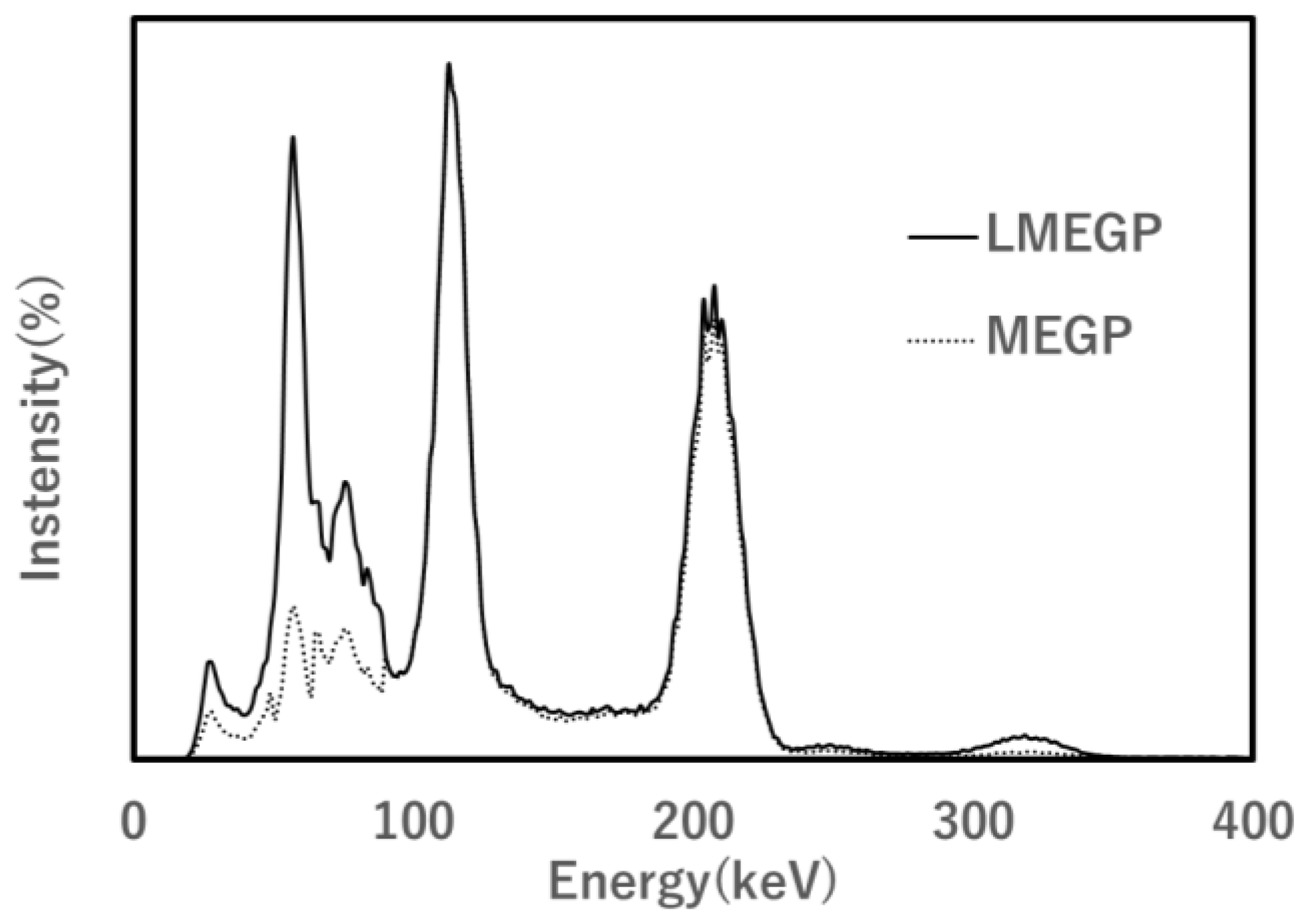Acquisition Conditions for Lu-177 DOTATATE Imaging
Abstract
:Simple Summary
Abstract
1. Introduction
2. Materials and Methods
2.1. System Condition
2.2. Total Spatial Resolution
2.3. Phantom Study
2.3.1. Static Images
2.3.2. SPECT Images
2.4. Human Study
2.5. Statistics
3. Results
3.1. Total Spatial Resolution
3.2. Phantom Study
3.2.1. Static Image
3.2.2. SPECT Image
3.2.3. Human Study
4. Discussion
5. Conclusions
Author Contributions
Funding
Institutional Review Board Statement
Informed Consent Statement
Data Availability Statement
Conflicts of Interest
References
- Hosono, M.; Ikebuchi, H.; Nakamura, Y.; Nakamura, N.; Yamada, T.; Yanagida, S.; Kitaoka, A.; Kojima, K.; Sugano, H.; Kinuya, S.; et al. Manual on the proper use of lutetium-177-labeled somatostatin analogue (Lu-177-DOTA-TATE) injectable in radionuclide therapy (2nd ed.). Ann. Nucl. Med. 2018, 32, 217–235. [Google Scholar] [CrossRef] [PubMed]
- Kawata, T. Radiopharmaceuticals/Peptide Receptor Radionuclide Therapeutics, LUTATHERA® Injection, Lutetium (177Lu) oxodotreotide. Drug Deliv. Syst. 2023, 38, 165–170. [Google Scholar] [CrossRef]
- Oberg, K.; Kvols, L.; Caplin, M.; Delle Fave, G.; de Herder, W.; Rindi, G.; Ruszniewski, P.; Woltering, E.A.; Wiedenmann, B. Consensus report on the use of somatostatin analogs for the management of neuroendocrine tumors of the gastroenteropancreatic system. Ann. Oncol. 2004, 15, 966–973. [Google Scholar] [CrossRef] [PubMed]
- Asmi, H.; Bentayeb, F.; Bouzekraoui, Y.; Bonutti, F.; Douama, S. Energy Window and Collimator Optimization in Lutetium-177 Single-photon Emission Computed Tomography Imaging using Monte Carlo Simulation. Indian J. Nucl. Med. 2020, 35, 36–39. [Google Scholar]
- Huizing, D.M.V.; Sinaasappel, M.; Dekker, M.C.; Stokkel, M.P.M.; de Wit-van der Veen, B.J. 177 Lutetium SPECT/CT: Evaluation of collimator, photopeak and scatter correction. J. Appl. Clin. Med. Phys. 2020, 21, 272–277. [Google Scholar] [CrossRef]
- Kojima, A.; Takagi, A.; Noguchi, T.; Matsumoto, M.; Katsuda, N.; Tomiguchi, S.; Yamashita, Y. Optimum energy window setting on Hg-201 x-rays photopeak for effective Tl-201 imaging. Ann. Nucl. Med. 2005, 19, 541–547. [Google Scholar] [CrossRef] [PubMed]
- Chu, S.Y.F.; Ekström, L.P.; Firestone, R.B. Table of Isotopes. Database Version 1999-02-28. Available online: http://nucleardata.nuclear.lu.se/toi/nuclide.asp?iZA=710177 (accessed on 2 October 2023).
- Kanzaki, T.; Takahashi, Y.; Higuchi, T.; Zhang, X.; Mogi, N.; Suto, T.; Tsushima, Y. Evaluation of a Correction Method for 111In-Pentetreotide SPECT Imaging of Gastroenteropancreatic Neuroendocrine Tumors. J. Nucl. Med. Tech. 2020, 48, 326–330. [Google Scholar] [CrossRef] [PubMed]
- Yamashita, K.; Miyaji, N.; Motegi, K.; Terauchi, T.; Ito, S. Development of a new quantification method using partial volume effect correction for individual energy peaks in 111In-pentetreotide SPECT/CT. Asia Ocean. J. Nucl. Med. Biol. 2022, 10, 126–137. [Google Scholar] [CrossRef]
- National Electrical Manufacturers Association. Performance Measurements of Gamma Cameras NEMA Standards Publication NU 1-2018; National Electrical Manufacturers Association: Rosslyn, VA, USA, 2019; pp. 42–46. [Google Scholar]
- Inoue, T.; Ootake, H.; Hirano, T.; Tomiyoshi, K.; Endo, K.; Tanaka, K.; Shimizu, N.; Saito, T. Pharmacokinetics and dosimetry of the somatostatin analog 111In-DTPA-D-Phe-Octreotide -Report of the phase 1 study-. Jpn. J. Nucl. Med. (KAKUIGAKU) 1995, 32, 511–521. (In Japanese) [Google Scholar]
- Öhrvall, U.; Westlin, J.E.; Nilsson, S.; Wilander, E.; Juhlin, C.; Rastad, J.; Akerström, G. Human Biodistribution od [111In]Diethylenetriamine- pentaacetic Acid-(DTPA)-D-[Phe1]-octreotide and peroperative detection of endocrine tumors. Cancer Res. 1995, 55 (Suppl. 23), 5794s–5800s. [Google Scholar] [PubMed]
- Kwekkeboom, D.J.; Teunissen, J.J.; Bakker, W.H.; Kooij, P.P.; de Herder, W.W.; Feelders, R.A.; van Eijck, C.H.; Esser, J.P.; Kam, B.L.; Krenning, E.P. Radiolabeled Somatostatin Analog [177Lu-DOTA0,Tyr3]Octreotate in Patients with Endocrine Gastroenteropancreatic Tumors. J. Clin. Oncol. 2005, 23, 2754–2762. [Google Scholar] [CrossRef] [PubMed]
- Tsuta, K.; Wistuba, I.I.; Moran, C.A. Differential expression of somatostatin receptors 1-5 in neuroendocrine carcinoma of the lung. Rathol. Res. Pract. 2012, 208, 470–474. [Google Scholar] [CrossRef] [PubMed]
- Ito, T.; Igarashi, H.; Nakamura, K.; Sasano, H.; Okusaka, T.; Takano, K.; Komoto, I.; Tanaka, M.; Imamura, M.; Jensen, R.T.; et al. Epidemiological trends of pancreatic and gastrointestinal neuroendocrine tumors in Japan: A nationwide survey analysis. J. Gastroenterol. 2015, 50, 58–64. [Google Scholar] [CrossRef] [PubMed]
- Roth, D.; Larsson, E.; Sundlöv, A.; Sjögreen Gleisner, K. Characterisation of a hand-held CZT-based gamma camera for 177Lu imaging. EJNMMI Phys. 2020, 7, 46. [Google Scholar] [CrossRef] [PubMed]
- Kelkar, S.S.; Reineke, T.M. Theranostics: Combining imaging and therapy. Bioconjug. Chem. 2011, 22, 1879–1903. [Google Scholar] [CrossRef] [PubMed]
- Sharma, R.; Wang, W.M.; Yusuf, S.; Evans, J.; Ramaswami, R.; Wernig, F.; Frilling, A.; Mauri, F.; Al-Nahhas, A.; Aboagye, E.O.; et al. Ga-DOTATATE PET/CT parameters predict response to peptide receptor radionuclide therapy in neuroendocrine tumours. Radiother. Oncol. 2019, 141, 108–115. [Google Scholar] [CrossRef] [PubMed]
- Duan, H.; Iagaru, A.; Aparici, C.M. Radiotheranostics—Precision Medicine in Nuclear Medicine and Molecular Imaging. Nanotheranostics 2022, 6, 103–117. [Google Scholar] [CrossRef] [PubMed]









Disclaimer/Publisher’s Note: The statements, opinions and data contained in all publications are solely those of the individual author(s) and contributor(s) and not of MDPI and/or the editor(s). MDPI and/or the editor(s) disclaim responsibility for any injury to people or property resulting from any ideas, methods, instructions or products referred to in the content. |
© 2024 by the authors. Licensee MDPI, Basel, Switzerland. This article is an open access article distributed under the terms and conditions of the Creative Commons Attribution (CC BY) license (https://creativecommons.org/licenses/by/4.0/).
Share and Cite
Sagisaka, Y.; Takahashi, Y.; Hosokawa, S.; Kanazawa, N.; Yamamoto, H.; Takai, G.; Nagano, K. Acquisition Conditions for Lu-177 DOTATATE Imaging. Radiation 2024, 4, 17-25. https://doi.org/10.3390/radiation4010002
Sagisaka Y, Takahashi Y, Hosokawa S, Kanazawa N, Yamamoto H, Takai G, Nagano K. Acquisition Conditions for Lu-177 DOTATATE Imaging. Radiation. 2024; 4(1):17-25. https://doi.org/10.3390/radiation4010002
Chicago/Turabian StyleSagisaka, Yuri, Yasuyuki Takahashi, Shota Hosokawa, Niina Kanazawa, Hiroki Yamamoto, Go Takai, and Keiji Nagano. 2024. "Acquisition Conditions for Lu-177 DOTATATE Imaging" Radiation 4, no. 1: 17-25. https://doi.org/10.3390/radiation4010002
APA StyleSagisaka, Y., Takahashi, Y., Hosokawa, S., Kanazawa, N., Yamamoto, H., Takai, G., & Nagano, K. (2024). Acquisition Conditions for Lu-177 DOTATATE Imaging. Radiation, 4(1), 17-25. https://doi.org/10.3390/radiation4010002




